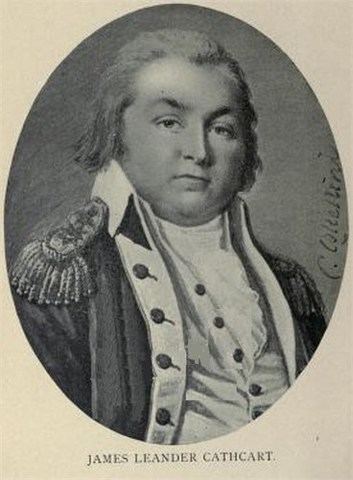Name James Cathcart Role Sailor | Children Charles W. Cathcart | |
 | ||
Died October 6, 1843, Washington, D.C., United States Books Tripoli: First War with the United States | ||
James leander cathcart an american slave in algiers
James Leander Cathcart (1 June 1767 – 6 October 1843) was a diplomat, slave, and sailor. He is notable for his narrative as a slave in Algiers for eleven years.
Contents
- James leander cathcart an american slave in algiers
- Revolutionary War
- Slave in Algiers
- Personal
- Professional diplomatic career
- References
Revolutionary War
Cathcart was born in Mount Murragh, County Westmeath, Ireland and emigrated to the North American colonies at eight years of age, under the care of a relative, Captain John Cathcart. He joined the American Revolution and at the age of twelve served on a privateer. Three years later, as a midshipman on The Confederacy, he was captured by the British and imprisoned on the prisoner ships, The Good Hope and Jersey from which he escaped in 1782. He became fluent in Spanish and French, which he learned from fellow prisoners during his three-year internment.
Slave in Algiers
In 1785 Barbary pirates captured the American merchant ship The Maria Boston, on its way to Cadiz carrying furs, lumber, and dried codfish. They took Cathcart and twenty other sailors as slaves. During the eleven years of his slavery in Algiers Cathcart managed by means of good fortune, cleverness, and bribery to improve his circumstances, eventually becoming chief clerk to the Dey. In this position, he acted as a mediator between the Dey and Joseph Donaldson, Jr. agent for Colonel David Humphreys, the U.S. Minister to Portugal, that resulted in The Treaty of Algiers of 1796 and made possible his freedom.
Cathcart, for the first several years of his captivity, endured the same terrible living conditions as his fellow slaves. One of a few handpicked by the Dey, Cathcart’s first duties were to work in the Dey’s palace garden caring for the lions, tigers, and antelopes. Although his assigned duties were relatively light, his masters provided scant food and administered several beatings, called bastinado, where in one instance Cathcart lost several of his toenails.
As his fortunes and positions in Algiers improved, Cathcart acquired additional skills that he used later as a diplomat. He found opportunities to demonstrate his concern for his fellow prisoners. During his slavery he became conversant in Arabic and Turkish. When Cathcart became clerk of the prison, he was able to buy several taverns, a house with servants, and procure more food for his fellow crew members. After the Treaty of Algiers freed them, Cathcart had the means to purchase a ship, which he sailed to Philadelphia in 1796 with twelve surviving members of the original crew.
Personal
On 5 June 1798 he married Philadelphia belle Jane Bancker Woodside, and they had twelve children. His daughter JB Newkirk put together Cathcart’s narrative and published it in 1899, 56 years after his death, under the title of The Captives, Eleven Years a Prisoner in Algiers.
Professional diplomatic career
He returned to the Barbary Coast in December 1798, as special agent to William Eaton. In 1802, he was appointed US Consul to Tunis and Tripoli. He participated in the negotiation of additional treaties with Algiers, Tunis, and Tripoli. He served as Consul-General for the United States in Cádiz from 1807–17. Cathcart served in the diplomatic corps for the United States during the administrations of John Adams, Thomas Jefferson, and James Madison.
